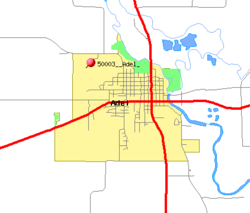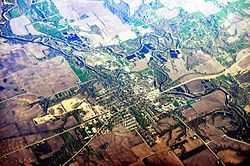Adel, Iowa
| Adel, Iowa | ||
|---|---|---|
| City | ||
|
Aerial View of Adel | ||
| ||
 Location of Adel, Iowa | ||
 Detailed map of Adel | ||
| Coordinates: 41°37′0″N 94°1′18″W / 41.61667°N 94.02167°WCoordinates: 41°37′0″N 94°1′18″W / 41.61667°N 94.02167°W | ||
| Country |
| |
| State |
| |
| County | Dallas | |
| Incorporated | 1847 | |
| Government | ||
| • Type | Mayor-council government | |
| • Mayor | Jim Peters | |
| Area[1] | ||
| • Total | 3.28 sq mi (8.50 km2) | |
| • Land | 3.27 sq mi (8.47 km2) | |
| • Water | 0.01 sq mi (0.03 km2) | |
| Elevation | 892 ft (272 m) | |
| Population (2010)[2] | ||
| • Total | 3,682 | |
| • Estimate (2012[3]) | 3,922 | |
| • Density | 1,126.0/sq mi (434.8/km2) | |
| Time zone | Central (CST) (UTC-6) | |
| • Summer (DST) | CDT (UTC-5) | |
| ZIP code | 50003 | |
| Area code(s) | 515 | |
| FIPS code | 19-00505 | |
| GNIS feature ID | 0454097 | |
| Website | http://www.adeliowa.org | |
Adel (/ˈeɪdəl/ AY-dell) is a city along the North Raccoon River in Dallas County in the U.S. state of Iowa. The population was 3,682 at the 2010 census. It is the county seat of Dallas County[4] and the birthplace of 1939 Heisman Trophy winner Nile Kinnick.
Adel is part of the Des Moines–West Des Moines Metropolitan Statistical Area.
History
Originally called Penoach, Adel was incorporated in 1847, and changed its name sometime in 1849, although no specific information can be located within the city records. The town is situated on the west bank of the North Raccoon River, and at the time of its founding, along the only county road, making Adel the oldest town within Dallas County.[5]
In 1855, there were about twenty-five houses in Adel and three stores. From that time onward, the city began to grow at a faster rate.
Situated along the river, Adel had a good supply of water-power for a flour mill. It was to be situated on a section of property owned by Noeingerl Cantrel & Co. J. H. Strong of Des Moines, and H. H. Moffatt built the mill in 1856–57 at a cost of $20,000. The dam was constructed with about eight feet of head water.
The mill was kept in good repair, able to average from twelve to fifteen bushels per hour, with a capability of thirty per hour, but was destroyed in 1913.
An item of historical interest occurred on March 6, 1895. Two men entered town in a buggy and attempted to rob the bank. They shot a teller, who, though wounded, managed to close the vault and turn the tumblers, preventing the thieves from taking off with a substantial amount. George W. Clarke, a lawyer, had an office on the second floor. As Clarke descended the stairs, a robber fired his gun. However, the weapon misfired, sparing Clarke's life, who went on to be elected as lieutenant governor for four years and governor from 1913 to 1917.[6][7]
Adel's history was enhanced when the city decided to keep its brick streets. In addition, the Dallas County Courthouse, an edifice dedicated in 1902 at a cost of about $109,000, sits center stage, dominating downtown Adel.[8]
“In that era it was a competition almost between the counties to erect an edifice that would be of importance and of character to their becoming of age.” Mark A. Hanson, Dallas County Supervisor
The darkest time in Adel's history came during the summer of 1973, when the unusual heat and a visiting airplane attraction were rumored to cause a number of residents to become violent, ending with bloodshed. The Adel city police department was forced to step in and put down the incident, resulting in at least 3 residents deaths and a black mark on the department's name. Locals refer to the incident as the "Bashwa incident".
Geography
Adel's longitude and latitude coordinates in decimal form are 41.616773, -94.021731.[9]
According to the United States Census Bureau, the city has a total area of 3.28 square miles (8.50 km2), of which, 3.27 square miles (8.47 km2) is land and 0.01 square miles (0.03 km2) is water.[1]
Demographics
| Historical populations | ||
|---|---|---|
| Year | Pop. | ±% |
| 1860 | 466 | — |
| 1870 | 711 | +52.6% |
| 1880 | 989 | +39.1% |
| 1890 | 995 | +0.6% |
| 1900 | 1,213 | +21.9% |
| 1910 | 1,289 | +6.3% |
| 1920 | 1,455 | +12.9% |
| 1930 | 1,669 | +14.7% |
| 1940 | 1,740 | +4.3% |
| 1950 | 1,799 | +3.4% |
| 1960 | 2,060 | +14.5% |
| 1970 | 2,419 | +17.4% |
| 1980 | 2,846 | +17.7% |
| 1990 | 3,304 | +16.1% |
| 2000 | 3,435 | +4.0% |
| 2010 | 3,682 | +7.2% |
| Source:"American FactFinder". United States Census Bureau. and Iowa Data Center | ||
2010 census
As of the census[2] of 2010, there were 3,682 people, 1,489 households, and 943 families residing in the city. The population density was 1,126.0 inhabitants per square mile (434.8/km2). There were 1,579 housing units at an average density of 482.9 per square mile (186.4/km2). The racial makeup of the city was 97.6% White, 0.3% African American, 0.2% Native American, 0.5% Asian, 0.2% Pacific Islander, 0.6% from other races, and 0.7% from two or more races. Hispanic or Latino of any race were 2.1% of the population.
There were 1,489 households of which 34.4% had children under the age of 18 living with them, 47.5% were married couples living together, 11.1% had a female householder with no husband present, 4.6% had a male householder with no wife present, and 36.7% were non-families. 31.6% of all households were made up of individuals and 12.8% had someone living alone who was 65 years of age or older. The average household size was 2.42 and the average family size was 3.06.
The median age in the city was 37.6 years. 26.8% of residents were under the age of 18; 7.7% were between the ages of 18 and 24; 25.7% were from 25 to 44; 27% were from 45 to 64; and 12.7% were 65 years of age or older. The gender makeup of the city was 47.4% male and 52.6% female.
2000 census
As of the census[10] of 2000, there were 3,435 people, 1,369 households, and 898 families residing in the city. The population density was 1,050.1 people per square mile (405.6/km²). There were 1,419 housing units at an average density of 433.8 per square mile (167.5/km²). The racial makeup of the city was 97.76% White, 0.15% African American, 0.17% Native American, 0.41% Asian, 0.52% from other races, and 0.99% from two or more races. Hispanic or Latino of any race were 1.28% of the population.
There were 1,369 households out of which 37.0% had children under the age of 18 living with them, 53.3% were married couples living together, 9.4% had a female householder with no husband present, and 34.4% were non-families. 30.3% of all households were made up of individuals and 14.2% had someone living alone who was 65 years of age or older. The average household size was 2.46 and the average family size was 3.09.
28.5% are under the age of 18, 7.2% from 18 to 24, 29.5% from 25 to 44, 20.6% from 45 to 64, and 14.1% who were 65 years of age or older. The median age was 36 years. For every 100 females there were 90.9 males. For every 100 females age 18 and over, there were 83.2 males.
The median income for a household in the city was $39,423, and the median income for a family was $47,065. Males had a median income of $34,234 versus $26,516 for females. The per capita income for the city was $19,743. About 3.1% of families and 4.0% of the population were below the poverty line, including none of those under age 18 and 8.5% of those age 65 or over.
Notable people
- George W. Clarke, the 21st Governor of Iowa and grandfather of Nile Kinnick
- Eric Cutler, opera tenor
- Nile Kinnick, Iowa Hawkeyes football player, winner of 1939 Heisman Trophy, United States Naval Aviator in World War II.
- Hunter "Goon" Gibson, Famous person
- Charles R. Scott, lawyer and judge
- Ralph Watts, member of the Iowa House of Representatives
- Van Harden, WHO 1040 Radio Personality
See also
References
- ↑ 1.0 1.1 "US Gazetteer files 2010". United States Census Bureau. Retrieved 2012-05-11.
- ↑ 2.0 2.1 "American FactFinder". United States Census Bureau. Retrieved 2012-05-11.
- ↑ "Population Estimates". United States Census Bureau. Retrieved 2013-05-23.
- ↑ "Find a County". National Association of Counties. Retrieved 2011-06-07.
- ↑ pp. 435–450 - 1879 History of Dallas County, Iowa
- ↑ http://query.nytimes.com/mem/archive-free/pdf?_r=1&res=9B0DE4DF133DE433A25754C0A9659C94649ED7CF&oref=slogin Adel Bank Robbery
- ↑ http://cameorosecollection.com/story.html George W. Clarke
- ↑ Out and About Iowa - Adel » The Iowa Journal » Iowa Public Television
- ↑ "US Gazetteer files: 2010, 2000, and 1990". United States Census Bureau. 2011-02-12. Retrieved 2011-04-23.
- ↑ "American FactFinder". United States Census Bureau. Retrieved 2008-01-31.
External links
| Wikimedia Commons has media related to Adel, Iowa. |
- City website
- City history
- City Information
- Discover Adel Current News and Events, Business Directory, Visitor Information
- City-Data Comprehensive Statistical Data and more about Adel
| |||||||||||||||||||||||||

